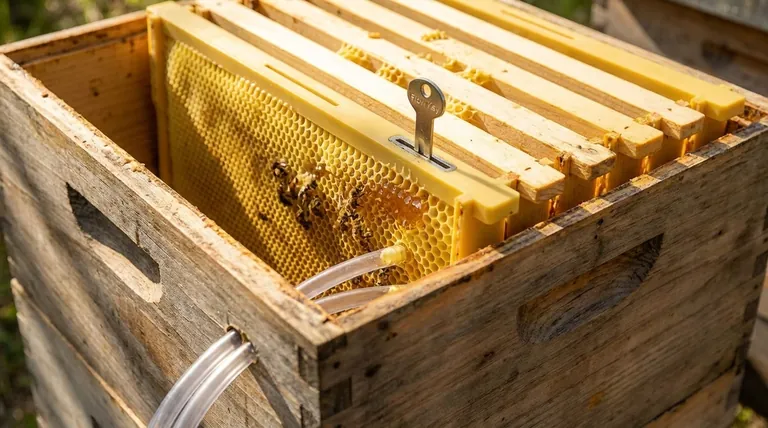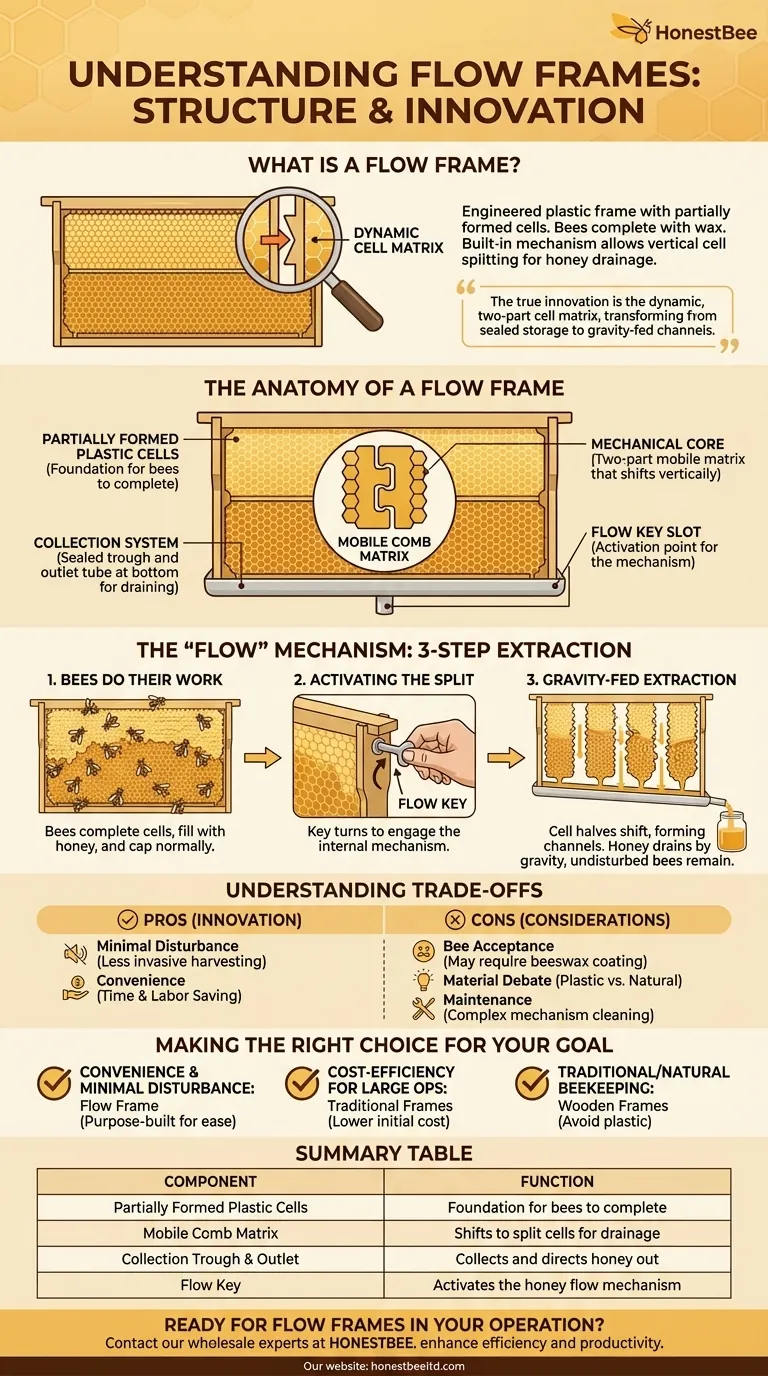At its core, a Flow Frame is an engineered plastic beehive frame containing partially formed honeycomb cells. Bees complete these cells with their own wax, fill them with honey, and cap them as they normally would. The frame's key innovation lies in a built-in mechanism that allows the beekeeper to split the cells vertically, creating channels for the honey to drain directly out of the hive.
The true innovation of a Flow Frame is not just its plastic construction, but its dynamic, two-part cell matrix. This design allows it to transform from a sealed honeycomb storage unit into a series of gravity-fed channels with the simple turn of a key.

The Anatomy of a Flow Frame
To understand how a Flow Frame works, you must first understand its fundamental components. It looks like a standard beehive frame but contains a sophisticated internal structure.
The Foundation: Partially Formed Plastic Cells
The frame itself is made from food-grade, BPA-free plastic. The surface on both sides is molded into a partial honeycomb pattern. This acts as a foundation, which the bees complete by drawing out the cells to full depth using their own wax.
The Mechanical Core: A Mobile Comb Matrix
This is the most critical part of the design. The honeycomb cells are not one solid piece. Instead, each side of the comb is a separate, interlocking part. When the frame is "reset," these parts align perfectly to form intact, hexagonal cells. When the mechanism is activated, one part shifts vertically against the other.
The Collection System: Trough and Outlet
At the bottom of the frame is a sealed trough designed to collect the draining honey. This trough leads to an exit port at the top of the frame, allowing honey to flow through a tube and directly into a collection jar outside the hive.
The "Flow" Mechanism: From Sealed Cell to Honey Channel
The structure is designed to facilitate a specific, three-step process for honey extraction that minimizes disturbance to the colony.
Step 1: The Bees Do Their Work
First, the beekeeper places the Flow Frames into the hive's honey super. The bees then accept the frame, complete the cells with wax, fill them with honey, and cap the cells once the honey is cured.
Step 2: Activating the Split with the Flow Key
Once the frame is full and capped, the beekeeper inserts a tool called the Flow Key into an operating slot at the top or bottom of the frame. Turning this key 90 degrees engages the internal mechanism, shifting the two parts of the honeycomb.
Step 3: Gravity-Fed Honey Extraction
This vertical shift misaligns the cell halves, breaking the wax cappings and turning the sealed cells into a series of open, vertical channels. Gravity then takes over, and the honey flows down these channels, into the collection trough, and out of the hive—all while the bees remain undisturbed on the surface of the comb.
Understanding the Trade-offs
While the design is innovative, it's essential to consider the implications and common points of discussion within the beekeeping community.
Bee Acceptance and Adaptation
Some colonies may be slower to accept and build upon plastic foundations compared to traditional beeswax. Beekeepers sometimes need to encourage the bees by lightly coating the plastic frames with beeswax to promote adoption.
Material Considerations
The use of plastic within the hive is a point of philosophical debate for some beekeepers. While Flow Frames use high-quality, food-grade plastic, purists often prefer to keep the internal environment of the hive to just wood and wax.
Maintenance and Cleaning
The complex internal mechanism of a Flow Frame can be more challenging to clean than a simple wooden frame and wax foundation. Proper maintenance is required to ensure the mechanism operates smoothly over time.
Making the Right Choice for Your Goal
Ultimately, the structure of the Flow Frame is engineered for a specific purpose. Your decision to use it should align with your beekeeping objectives.
- If your primary focus is convenience and minimal disturbance: The Flow Frame's design is purpose-built to make harvesting less invasive and physically demanding.
- If your primary focus is cost-efficiency for a large operation: The higher initial cost per frame may be a significant factor compared to traditional, lower-cost wooden frames.
- If your primary focus is traditional or "natural" beekeeping: You may prefer to stick with wooden frames and all-wax foundations to avoid introducing plastic into the brood nest or honey supers.
Understanding the mechanical genius of the Flow Frame empowers you to decide if this technology fits your personal beekeeping philosophy.
Summary Table:
| Component | Function |
|---|---|
| Partially Formed Plastic Cells | Acts as a foundation for bees to complete with wax. |
| Mobile Comb Matrix | Two-part design that shifts to split cells for honey drainage. |
| Collection Trough & Outlet | Collects honey from the frame and directs it out of the hive. |
| Flow Key | Tool used to activate the mechanism and start the honey flow. |
Ready to experience the convenience of Flow Frames in your operation?
At HONESTBEE, we supply commercial apiaries and beekeeping equipment distributors with the high-quality tools they need to succeed. Our Flow Frames can transform your honey harvesting process, saving you significant time and labor while minimizing stress on your bee colonies.
Contact our wholesale experts today to discuss how our beekeeping supplies can enhance your efficiency and productivity.
Visual Guide

Related Products
- 7 x Auto Bee Flow Hive Frames Plastic Beekeeping Hive Box Supplies
- Plastic Bee Frame Beekeeping Hive Frames for Wholesale
- 3.5L Plastic Beehive Frame Feeder Deep Frame Water Feeder for In Hive Use
- Professional In-Hive Bee Feeder HONESTBEE Frame for Beekeeping
- Heart-Shaped Comb Honey Frame and Honeycomb Cassette
People Also Ask
- How to extract honey in Flow Hives? Experience the Simplicity of Honey on Tap
- What is the selling point of the Flow Hive? A Revolutionary, Stress-Free Honey Harvest
- What do bees do after the comb is reset in Flow Frames? Maximize Your Hive's Honey Production Efficiency
- How long does it take for bees to fill a Flow Hive? A Guide to Realistic Timelines
- What are the advantages of using an Auto Flow Hive? Experience Gentle, On-Tap Honey Harvesting



















